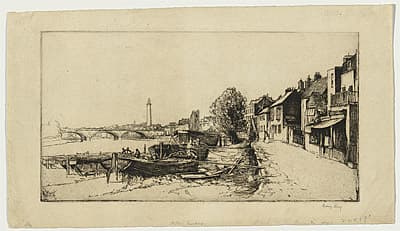
Sydney
LONG
Australia
1871
–
London
1955
England, Europe 1910-21; Australia 1921- 22; England 1922-25; Australia 1925-52; England from 1952
17.4 (h) x 32.5 (w) cm
12/30 , published state , edition of 30 , manufacturer's mark centre, 'N GELDER ZONEN [fragment, runs vertically]'
Signed lower right below plate-mark in black pencil, 'Sydney Long'. Inscribed with edition details lower left corner of sheet in black pencil, '12/30'. Inscribed lower centre of sheet in black pencil, 'NSW. Gallery'. Inscribed lower right of sheet in black pencil, 'Strand on the Green 2.'
Reference: Mendelssohn (1979), 59; Paul (1928), 21 National Gallery of Australia, Canberra NGA 1986.1275 Gift of T.S. Paul in memory of Dorothy Ellsmore Paul 1986 Reproduced with the kind permission of the Ophthalmic Research Institute of Australia
- Collection of the artist and cataloguer of Sydney Long's etchings, Dorothy Ellsmore Paul. Gift of her nephew T S Paul to the NGA, 1986.
‘In Strand on the Green number 3 we have a good example of the bitten line. Every line is drawn and etched to give full value to the design, there is a feeling of atmosphere, luminosity, and also a great quietness’
(Paul 1928, p 4)
The Strand-on-the-green is an area of Chiswick in West London, immediately to the east of Kew Bridge, along the north bank of the Thames. The area is a picturesque part of London, with a footpath along the river overlooked by imposing 18th-century houses and local pubs. It was established in the Middle Ages as a fishermen’s settlement. In the 18th century, members of the nobility and gentry settled there because it was near Kew and the Royal family’s residence. The 18th-century British portrait painter Johann Zoffany also lived there. The British artist Frank Brangwyn was one of a number of artists who were attracted to the area, making a painting and two etchings titled ‘Strand on the green’.
The subject was one Long returned to several times. He sent Adolph Albers a watercolour of ‘Strand on the green and Kew Bridge’ in May 1918. And he made two other etchings of the subject, titled ‘Strand on the green, no 1’ (NGA and AGNSW) and ‘Strand on the green, no 2’ (NGA)
A copy of Strand on the green, no 3 was first exhibited 1924 at the ‘Fourth annual exhibition of the Australian Painter–Etchers’ Society’, Sydney, 1–13 December (65). Copies, one in brown ink and one in black ink, are held by the Art Gallery of New South Wales, and a copy is held by the Tasmanian Museum and Art Gallery.
‘In Strand on the Green number 3 we have a good example of the bitten line. Every line is drawn and etched to give full value to the design, there is a feeling of atmosphere, luminosity, and also a great quietness’
(Paul 1928, p 4)
The Strand-on-the-green is an area of Chiswick in West London, immediately to the east of Kew Bridge, along the north bank of the Thames. The area is a picturesque part of London, with a footpath along the river overlooked by imposing 18th-century houses and local pubs. It was established in the Middle Ages as a fishermen’s settlement. In the 18th century, members of the nobility and gentry settled there because it was near Kew and the Royal family’s residence. The 18th-century British portrait painter Johann Zoffany also lived there. The British artist Frank Brangwyn was one of a number of artists who were attracted to the area, making a painting and two etchings titled ‘Strand on the green’.
The subject was one Long returned to several times. He sent Adolph Albers a watercolour of ‘Strand on the green and Kew Bridge’ in May 1918. And he made two other etchings of the subject, titled ‘Strand on the green, no 1’ (NGA and AGNSW) and ‘Strand on the green, no 2’ (NGA)
A copy of Strand on the green, no 3 was first exhibited 1924 at the ‘Fourth annual exhibition of the Australian Painter–Etchers’ Society’, Sydney, 1–13 December (65). Copies, one in brown ink and one in black ink, are held by the Art Gallery of New South Wales, and a copy is held by the Tasmanian Museum and Art Gallery.
‘In Strand on the Green number 3 we have a good example of the bitten line. Every line is drawn and etched to give full value to the design, there is a feeling of atmosphere, luminosity, and also a great quietness’
(Paul 1928, p 4)
The Strand-on-the-green is an area of Chiswick in West London, immediately to the east of Kew Bridge, along the north bank of the Thames. The area is a picturesque part of London, with a footpath along the river overlooked by imposing 18th-century houses and local pubs. It was established in the Middle Ages as a fishermen’s settlement. In the 18th century, members of the nobility and gentry settled there because it was near Kew and the Royal family’s residence. The 18th-century British portrait painter Johann Zoffany also lived there. The British artist Frank Brangwyn was one of a number of artists who were attracted to the area, making a painting and two etchings titled ‘Strand on the green’.
The subject was one Long returned to several times. He sent Adolph Albers a watercolour of ‘Strand on the green and Kew Bridge’ in May 1918. And he made two other etchings of the subject, titled ‘Strand on the green, no 1’ (NGA and AGNSW) and ‘Strand on the green, no 2’ (NGA)
A copy of Strand on the green, no 3 was first exhibited 1924 at the ‘Fourth annual exhibition of the Australian Painter–Etchers’ Society’, Sydney, 1–13 December (65). Copies, one in brown ink and one in black ink, are held by the Art Gallery of New South Wales, and a copy is held by the Tasmanian Museum and Art Gallery.
